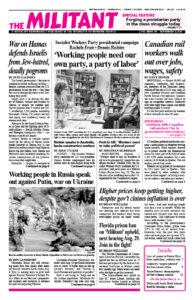Democrats and the liberal media are claiming that inflation has been conquered, but workers keep facing ever-higher prices on many essential items. And now working people also face a rise in layoffs. While the monthly pace of price increases has slowed over the past year, they never came down. This continues to wreak havoc with workers’ lives.
According to the government’s Consumer Price Index, prices rose 2.9% in July on an annual basis. However, over the past two years rents and mortgages are up over 13%, and water, sewer and trash-collection prices jumped nearly 11%.
“Inflation Hurts Most for the Things We Can’t Skimp On” an Aug. 12 Wall Street Journal article admitted. It noted, “Shoppers might be able to trade down from prime steak to cheaper cuts of meat at the supermarket, but they can’t really do the same thing with the water bill.”
In July alone, beef prices rose 8% and fresh fruit prices jumped 10%. Over the past three and a half years, grocery prices are up 22%, electricity rose 32%, car insurance is up nearly 40%, and gasoline, 50%. Over this same period, workers’ average wages have declined 3.9%.
The Labor Department said Aug. 21 that job openings for the past year ending in March were actually 818,000 less than the government had reported. The Biden administration had tried to disguise the depth of job losses.
In response to the squeeze on living standards, many workers are turning to their unions to fight for better wages and conditions. And more working people are looking for a political alternative to the bosses’ two main parties.
Neither Kamala Harris nor Donald Trump offer any answers to the capitalist economic crisis. In Raleigh, North Carolina, Aug. 16 Harris presented her “strategically vague economic message” that’s “light on detail,” as the New York Times described it.
Among her proposals are tax breaks for the wealthy owners of construction companies to press them to build more housing, and government deals with pharmaceutical companies to lower sky-high prices.
On Aug. 15 Harris showed what a government deal to ameliorate high drug prices would be like, joining with Joseph Biden to hail a deal with pharmaceutical companies. It didn’t offer anything in the way of affordable prescriptions.
The deal affects 10 drugs, including for cancer, diabetes and blood clots. For a month’s supply, Embrel, an arthritis drug, will cost $2,355, down from $7,402; Imbruvica, a blood-cancer drug, $9,319, down from $16,391; and Eliquis, a blood thinner, will cost $231, down from $594. None of these changes take effect until 2026. And at that point many of them will become available as generics.
According to the Consumer Financial Protection Bureau, 20% of U.S. households owed medical debts in 2022, totaling $88 billion. Much of this gets compounded by annual interest rates of over 20% charged by banks on unpaid credit card balances, tightening the squeeze on workers. This forces many into deeper debt and harassment by collection agencies.
Families are also paying higher costs for child care, which rose 6.4% over the past two years. In some cases workers face bills as high as their rent payments. The median price to put an infant in center-based care in 2022 was over $1,400 a month in major metropolitan areas, according to the Labor Department.
Squeeze on Social Security recipients
Millions of older workers are increasingly dependent on Social Security payments, but with rising costs for food, rent and medical care they’re finding it more difficult to get by. Some 40% rely on Social Security for half or more of their income, according to AARP.
For next year estimates are that the cost-of-living adjustment on Social Security will be just 2.6%, the average for the past 20 years. This is below the government’s inflation figures, imposing a cut in payments that millions depend upon to make it each month. On top of that, out of this meager increase, even higher amounts are automatically deducted to cover increased Medicare premiums.
It’s also becoming harder for workers to get decent full-time jobs. Hiring by bosses in a number categories — from retail workers and airport cleaners to industrial workers — is beginning to slow. A number of companies have been conducting what the Times describes as a “big silent layoff” by shrinking workforces through attrition and hiring fewer workers in a drive for profits.
Direct layoffs are also on the rise. Stellantis announced Aug. 9 the layoff of 2,450 autoworkers at its Ram truck plant in Warren, Michigan, beginning Oct. 8. John Deere, the world’s largest manufacturer of farm equipment, has cut 2,100 production jobs since November, 15% of its workforce. Thermon, a manufacturing and services firm in Austin, Texas, has cut 5% of its workforce in the past two years.
Spirit Airlines has stopped recruiting flight attendants, who have been protesting lousy pay and work schedules. The company is now asking some of them to take voluntary unpaid leaves of absence to cut costs. The airline is also furloughing about 240 pilots. Other job cuts announced earlier this year include 12,000 at UPS, about 3,000 at Xerox, and 2,350 at Macy’s. Continually higher costs and now layoffs highlight the need for a union-led fight to combat the twin scourges of joblessness and rising prices.

